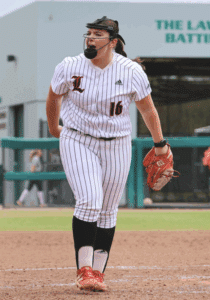Softball Pitch Types: The Ultimate Guide
Reading Time: 10 minutes
Reading Time: 10 minutes
Players need to learn how to throw multiple softball pitch types to be effective and keep batters on their toes. A powerful fastball is enough to be competitive in fastpitch softball. Various secondary and off speed pitches not only fool batters, but also make your fastball more impactful.
Softball coaching includes teaching the most basic softball pitch types – fastballs and changeups – to pitchers early in their journey. More advanced pitches like the drop pitch, curveballs, screwballs, and rise balls are reserved for more experienced players.

In this article, we’ll cover the most common softball pitch types including:
- Fastballs
- Changeups
- Drop pitches
- Curveballs
- Screwballs, and
- Rise balls
There are other pitches out there, but these are the core six that most softball pitchers learn throughout their career. Continue reading to learn about these common types of softball pitches, how they work, and tips to help you throw them more effectively.

Fastball
A fastball is the first pitch that any softball pitcher should learn. It is the fastest and straightest pitch in fast pitch softball, with a consistent trajectory and high velocity.
The mechanics for throwing a fastball set the foundation for all other pitches. It requires less finger and wrist strength, and is the safest pitch to introduce to young players while protecting their body.
To throw a fastball, grip the ball across the laces with your fingertips and focus on a loose, relaxed position in your hand. You generate power from your body’s lower half and stride length, and snap your wrist as you release to create spin. As you finish, follow through to roughly chest height.
There are two main fastball variations in softball:
- “C” Grip Four-Seam Fastball: Place your index, middle, and ring fingers across the c-shaped horseshoe seam with your thumb tucked underneath or to the side. This causes the seams to rotate vertically with all four seams visible during rotation, leading to the straight trajectory and high velocity.
- Two-Seam Fastball: Place your index and middle finger on the narrow seams that run parallel – created by the tops of the horseshoe seams. Alternatively, you can place your index, middle, and ring fingers on the top of the horseshoe seam with the opening facing down. There are additional alternate grips for two-seam fastballs as it’s not a one-grip-fits-all type of pitch. No matter how you grip it, only two seams are visible
Fastballs can be used at any time. A four-seam fastball’s straight trajectory makes it a controllable choice to get ahead early in the count, get one over when you need a strike, or put out a batter that’s behind in the count. A four-seamer on the outside corner can freeze batters.
Two-seamers have a sinking, arm-side break that leads to ground balls or swings and misses – making it a great choice as a put out pitch. Still, you can use a two-seam fastball to get ahead or sneak back in when you’re behind in the count.

Changeup
A change up is one of the slowest pitches thrown in softball. It’s typically the primary off speed pitch, especially for young players. A necessary off speed pitch to have in your repertoire, changeups keep batters guessing and off balance.
To throw a changeup, you need to grip the ball deeper in your hand. The key of an effective changeup is to keep your mechanics, motion, and release as close to identical to your fastball as possible. Your deeper grip causes the ball to come out slower.
Though numerous variations of the changeup grip exist in softball, the most common one is the circle changeup. To grip a circle changeup, hold the ball identical to your four-seam fastball grip, but further back in the hand.
Alternatively, you could use a two-seam grip – whatever you feel most comfortable with. Either way, slightly bend your pointer finger – making a circle with your thumb and pointer finger on the glove-side of the ball.
There are two ways to release a circle changeup:
- Backhand flip release: Lead with the back of your hand, so your wrist leads through with the ball. Keep your wrist slightly bent but loose so you can get a flip as you release. Follow through with your hand finishing down towards the catcher’s knees so the ball doesn’t stay up in the zone and hang.
- Push release: Hold the ball deep in your hand and release it like a fastball – with your palm facing up and the ball leading, not the top of your hand. As the ball releases, make sure you don’t whip or snap. Finish low to keep the ball down in the zone.
A knuckle changeup is another grip used by softball pitchers.
Changeups are used to fool batters and keep them guessing because they’re thrown slower than fastballs. You can throw it any time in the count. To get a strike early on in the count, throw your changeup in the zone but no higher than the knees. When you’re ahead, keep it low and in the dirt to get batters to chase.

Drop Pitch
A drop pitch is the first movement pitch to teach because it’s similar to a fastball in both mechanics and delivery. As its name suggests, a drop pitch sinks toward home plate as it approaches the batter. While some pitches in baseball drop, the specific “drop pitch” is unique to softball.
Rotation is essential – top spin generates the signature downward “drop” the pitch is named after. There are multiple ways to throw a drop pitch, but all begin with the same grip as a four-seam fastball. When you land, keep your weight forward and – without bending – angle your body like you’re pitching downhill. This helps with the drop and keeping the ball down in the zone.
There are two primary methods of throwing a drop pitch:
- Peel drop: Emphasize fingertip placement on top of the seams to generate more spin. Stay on top of the ball by extending your elbow further and straighter than a fastball, while keeping your wrist cocked backward before release. At the point of release, pull up so your fingertips “peel” aggressively off the ball and generate spin. Make your release quick and snap up with your fingertips as you finish. Everything should feel loose and natural, so be careful not to force the upward motion at release and during your finish.
- Turnover drop: Turn your hand over the ball to generate downward spin. Your hand needs to get down and out past the front leg on release. You generate rotation from the lower arm, wrist, and fingers. Your palm should go from facing up to facing the ground as you “turn over” – therefore the name.
The drop pitch tends to produce groundball outs or swings and misses because of the downward “dropping” trajectory. As the batter swings, the ball drops below where their bat anticipates, causing weak contact or a swinging strike. It’s a great option when there are runners on base, or when you’re ahead in the count and trying to get the batter to chase.
Just remember to emphasize keeping the drop pitch down in the zone. The lower in the zone, the more likely you are to force weak contact and misses. If you leave it hanging, players can capitalize on the poor command.

Curveball
A curve ball is the first pitch with horizontal movement to introduce to newer pitchers and younger athletes. It requires wrist and finger strength as a breaking pitch, so it’s taught later than the previous pitches.
To throw a curveball, use either a two-seam or four-seam grip – whatever you prefer. Keep your palm facing up during delivery. At release, twist your wrist from arm-side to glove-side (right to left for a right handed pitcher), throwing the ball across your body to generate tight spin. Your arm should stay tight to your body throughout, including your finish.
Curveballs have the most overall break of all softball pitch types included in this resource (some niche advanced pitches like the drop curve have more movement). The combination of movement and reduced velocity keeps hitters off-balance. If you throw it with higher velocity, you can get batters to freeze.
You can use a curveball at any point in a game. Throwing a curveball early in the count may catch the batter off guard and help you get ahead. When you have two strikes, you can use a curveball that breaks out of the zone to get protective batters to chase or a backdoor curve to freeze them.

Screwball
A screwball is a horizontal breaking ball designed to move the opposite direction of a curveball. Where a curveball breaks to the pitcher’s glove-side, a screwball breaks toward the arm-side batter’s box. Similar to a curveball, screwballs require finger and wrist strength. Because of the required strength, it’s best to introduce this pitch later in a player’s developmental progression.
To throw a screwball, there are multiple ways to grip the ball:
- Hold the ball with the open side of the horseshoe seam facing down, placing your index and middle fingers on the seam.
- Use a narrow two-seam grip with the middle and ring fingers resting on the respective seams, or
- Any other grip that you’re comfortable with
No matter what grip you use, it’s important to land slightly open with your front foot pushing out off the power line, opening your hips. Let your arm drop close to your body and – as you release – lead with your pinky finger, push your wrist through, and finish to your arm side.
The wrist rotation may feel awkward, but it helps leverage horizontal movement for arm-side break. It’s important to keep the ball down, targeting a low, arm-side of the plate location. A screwball can be used at any time – especially to get ahead early in the count or get a strikeout when you’re ahead. The more strikes you have, the further off the plate you should target.

Rise Ball
The rise ball is one of the most difficult softball pitch types to master. It requires a lot of wrist and finger strength to create backward spin. The combination of backward spin, arm angle, and leg lift leads to a perceived “rise” as it approaches the plate.
To see any effective movement, throwing velocity needs to be in the upper 50s or lower 60s (miles per hour). Because of the strength and velocity required, a rise ball is best saved for experienced, skilled pitchers.
To throw a rise ball, use either a four-seam or two-seam grip with your fingers on the seams or just next to them to generate necessary spin. You can either tuck your index finger back towards the hand or roll it so it makes a shape similar to a circle-changeup.
When positioning your body, lean your weight and shoulders back slightly to create an upward angle. As you throw, focus on a long, loose arm with your knuckles reaching toward the ground. Your pinky leads through release, snapping your wrist like you’re turning a doorknob in the process. Follow all the way through and finish high, reaching up toward your body with your thumb facing the sky.
A rise ball is a good pitch to throw when the batter is behind in the count. It can cause a batter protecting the plate to chase because the pitch starts like it’s in the strike zone, then rises up and out of the zone as it approaches them.

Conclusion
You can’t expect to master all of these pitches at once. For new pitchers and younger players, start with the basics: a four-seam fastball and/or two-seam fastball. Then, expand into easier off speed pitches: changeups and a drop pitch.
Once a pitcher gains enough experience and builds the required strength, incorporate more advanced pitches like a curveball, screwball, and/or rise ball.
Practice is the key to mastering any type of pitch in softball. With more repetitions, the pitches and required motions will feel more natural. Designating time in your softball practice plans for pitchers to work on different pitches helps build stronger repertoires.
Physical factors and kinematic parameters like elbow flexion and trunk rotation also play a major role so you should think about those as you teach and practice. Incorporate softball drills that work on grips and the physical motions.
As you develop new pitches, continue working on the basics so you have complete command of your entire repertoire. More importantly, as players grow, it’s important to focus on the logistics behind when and why you throw certain pitches.
With an arsenal of different softball pitch types and the knowledge of when to throw them, you’ll develop into an effective pitcher who batters dread facing.

FAQs About Softball Pitch Types
How many types of pitches are there in softball?
There are many different types of pitches that you can throw in softball. Six core pitch types – which most other pitches build off – include the fastball, changeup, drop pitch, curveball, screwball, and rise ball. Within each of those pitch types, there are multiple variations that you can throw – like a two-seam fastball and a four-seam fastball.
As you test different grips, wrist motion, body position, and other factors, you can incorporate more pitches into your arsenal.
What are the seven pitches in softball?
While there are many variations of pitches that can add up, there are six core pitches in softball. The six core pitches include:
- Fastball
- Changeup
- Drop ball
- Curveball
- Screwball, and
- Rise ball
What are the variations of softball pitches?
For many softball pitches, there are different variations in grip, mechanics, wrist movement, body position, or other components of pitching that alter the result of the pitch.
Some common examples include four-seam fastball versus two-seam fastball, circle changeup versus knuckle changeup, and peel drop versus turnover drop.
What is the hardest pitch to hit in softball?
The rise ball is the hardest pitch to hit in softball because it appears to be a normal fastball, but travels on an upward trajectory that “rises” as it approaches the batter. This leads batters to anticipate a strike and swing underneath the pitch as it rises up and out of the zone.
What are illegal pitches in softball?
An illegal pitch occurs in softball when pitchers use a physical motion that doesn’t follow the rules of their respective league. Some common illegal motions include crow hopping, re-planting, stepping outside the pitching lane, losing contact with the rubber, and stepping up to the rubber without separated hands.
Outside of physical motion, there is no grip that is deemed illegal in softball.







